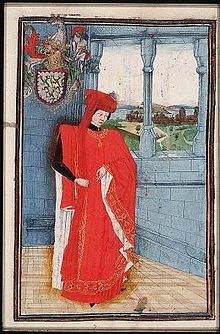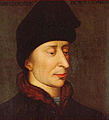Hugo von Lannoy
Hugo von Lannoy ( Dutch : Huyghe or Hugo van Lannoy , French: Hue or Hugues de Lannoy ), Lord of Santes (* 1384 - May 1, 1456 ) was a member of the West Flemish nobility , who lived in the first half of the 15th century in the service of the Burgundian dukes .
Life
Hugo von Lannoy came from the younger branch of the Flemish noble family Lannoy (French: Maison de Lannoy ). As a young knight he moved to Palestine to fight in the Holy Land and also took part in a campaign against the Tatars . After he returned from his journey to the East, he placed himself in the service of Johann Ohnefurcht , who had also gained experience on campaigns in the East. Johann, who inherited Flanders from his mother and Burgundy from his father , was deeply involved in the power struggles for power in what was then France. Although they were enemies with the supporters of the Duke of Orleans ( Armagnacs ), they went into battle more or less together against the English king.
In the autumn of 1415 Hugo von Lannoy, like his brother Ghillebert, fought with the Burgundian troops ( Bourguignons ) somewhat half-heartedly on the French side against the English troops in the Battle of Azincourt . The French were accordingly defeated and Hugo was taken prisoner. However, he was soon released again, and when in 1419, four years after the battle, John was killed by the opposing party, Lannoy was subsequently active in diplomatic missions under his successor, Philip the Good . In this way, he mediated the turbulence caused by the marriage of Johann Ohnefurcht's niece Jacoba von Baiern to Humphrey von Gloucester in 1422. The childless marriage was declared null and void as early as 1428 and it was agreed that Jacoba von Baiern would have to agree to remarry with the duke. However, when she had secretly married Frank van Borsselen in July 1432 and thus, in breach of contract , Philip the Good took possession of the counties of Holland , Zeeland and Hainaut in response , Hugo was appointed governor of the Duke of Burgundy for Holland and Hainaut the following year (1433) Zeeland used. He stayed that way until 1440. Together with his younger brothers Ghillebert and Bauduin , Hugo was accepted among the first 24 knights in the Order of the Golden Fleece when it was founded in 1430 by Philip the Good, which underlines his importance in the Burgundian court hierarchy. Hugo died childless in 1456 and was buried in Rijsel (now Lille ) in South Flanders . Since he had left no direct heirs, his brother Ghillebert bore the title of Lord of Santes from 1456.
literature
- Simona Slanička: War of Signs. The visual politics of Johann without fear and the Armagnakisch-Burgundian civil war. Vandenhoeck and Ruprecht Verlag, Göttingen 2002, ISBN 3-525-35178-X
- Raphaël de Smedt (ed.): Les chevaliers de l'ordre de la Toison d'or au XVe siècle. Notices bio-bibliographiques. 2nd edition, Peter Lang, Frankfurt 2000, ISBN 3-631-36017-7 ( Kieler Werkstücke . Series D, No. 3), pp. 14-17, No. 7.
Web links
proof
- ↑ Holzschuh-Hofer: The Feuereisen-Symbolik: Your requirements with Johann without fear and the introduction under Philip the Good
| personal data | |
|---|---|
| SURNAME | Hugo von Lannoy |
| ALTERNATIVE NAMES | Hugo van Lannoy |
| BRIEF DESCRIPTION | Member of the West Flemish nobility |
| DATE OF BIRTH | 1384 |
| DATE OF DEATH | May 1, 1456 |






